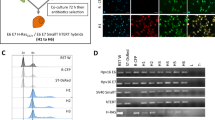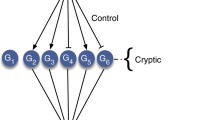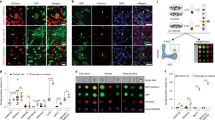Abstract
THREE strains of cells have recently been found which, unlike normal cells, do not make junctions of a kind that connects the cell interiors to each other1,2. These three strains are also cancerous1,2. We explore here whether the junctional defect is related to the cancerous state of these cells; we fuse cells of one of the strains with normal cells that make junctions and examine the junctional permeability and growth properties of the resulting hybrids. This approach is based on the findings of Harris and Klein and colleagues, and of Weiss, Todaro and Green, that tumorigenicity is markedly reduced3,4 and contact inhibition of growth resumed5 in hybrids between various kinds of cancer and normal cells. This also turned out to be the case with the present cell systems. The question is then, is the normalization of the growth properties associated with normalization of junctional connexion? The results show that both defects are corrected in the hybrids.
This is a preview of subscription content, access via your institution
Access options
Subscribe to this journal
Receive 51 print issues and online access
$199.00 per year
only $3.90 per issue
Buy this article
- Purchase on Springer Link
- Instant access to full article PDF
Prices may be subject to local taxes which are calculated during checkout
Similar content being viewed by others
References
Azarnia, R., and Loewenstein, W. R., J. Membrane Biol., 6, 368 (1971).
Borek, C., and Higashino, S., and Loewenstein, W. R., J. Membrane Biol., 1, 274 (1969).
Klein, G., Bregula, A. F., Wiener, F., and Harris, H., J. Cell Sci., 8, 659 (1971).
Harris, H., Proc. R. Soc. Lond., B, 179, 1 (1971).
Weiss, M. C., Todaro, J., and Green, H., J. Cell Physiol., 71, 105 (1968).
Harris, H., Cell Fusion, The Dunham Lectures (Clarendon Press, Oxford, 1970).
Loewenstein, W. R., and Kanno, Y., J. Cell Biol., 22, 565 (1964).
Kit, S., Dubs, L. J., Pickarski, T. C., and Hsu, S., Exp. Cell Research, 31, 297 (1963).
Szybalski, E. H., Szybalska, G., and Raghi, F., Nat. Cancer Inst. Monographs, 7, 75 (1962).
Littlefield, J. W., Science, 145, 709 (1964).
Vogt, M., and Dulbecco, R., Proc. US Nat. Acad. Sci., 46, 365 (1960).
Ham, R. G., Proc. US Nat. Acad. Sci., 53, 288 (1965).
Loewenstein, W. R., Ann. NY Acad. Sci., 137, 441 (1966).
Loewenstein, W. R., Perspectives in Biol. and Medicine, 11, 260 (1968).
Author information
Authors and Affiliations
Rights and permissions
About this article
Cite this article
AZARNIA, R., LOEWENSTEIN, W. Parallel Correction of Cancerous Growth and of a Genetic Defect of Cell-to-Cell Communication. Nature 241, 455–457 (1973). https://doi.org/10.1038/241455a0
Received:
Revised:
Issue Date:
DOI: https://doi.org/10.1038/241455a0
This article is cited by
-
Hybrids between normal cells, communication-deficient and communication-competent tumor cells
Protoplasma (1986)
-
Intercellular communication and tissue growth: VIII. A genetic analysis of junctional communication and cancerous growth
The Journal of Membrane Biology (1977)
Comments
By submitting a comment you agree to abide by our Terms and Community Guidelines. If you find something abusive or that does not comply with our terms or guidelines please flag it as inappropriate.



